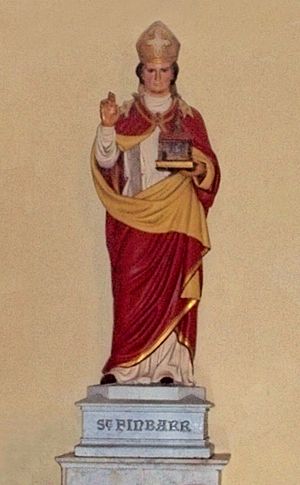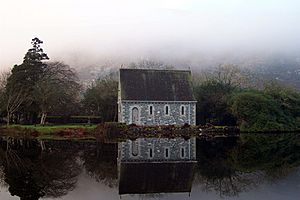Finbarr of Cork facts for kids
Quick facts for kids Finbar |
|
|---|---|
 |
|
| Bishop and Abbot | |
| Born | 550 Templemartin, north of Bandon, Ireland |
| Died | 623 Cellnaclona (Cloyne) in Ballineadig, County Cork, Ireland |
| Venerated in | Eastern Orthodox Church Roman Catholic Church |
| Major shrine | Gougane Barra, Saint Fin Barre's Cathedral (Anglican cathedral, Cork) |
| Feast | 25 September |
| Patronage | Cork, Diocese of Cork |
Saint Finbar, also known as Finnbar or Finnbarr, was an important Irish saint. His name in Irish is Fionnbharra, often shortened to Barra. He lived a long time ago, from about 550 AD to 623 AD. Saint Finbar was a bishop and the head of a monastery in what is now Cork city, Ireland. He is considered the patron saint of Cork city and the area around it. People celebrate his feast day every year on September 25.
The Life of Saint Finbar
Finbar was born in a place called Templemartin, near Bandon. His first name was Lóchán. His father, Amergin, was a skilled craftsman from Galway. Finbar went to study in a region called Ossory, which is now mostly County Kilkenny.
He got the name "Fionnbharra," which means "Fairhead" in Irish. This happened when he had his hair cut short in a special way for monks, called a tonsure. The person cutting his hair said, "Fair is the crest of Loan," referring to his bright hair. From then on, he was known as Finbar.
After his studies, he went on a special trip, called a pilgrimage, to Rome with some other monks. On their way back, they visited St David in Wales.
When he finished his education, Finbar returned home. For some time, he lived on an island in a small lake called Loch Irce. Today, this island is known as Gougane Barra. It means "the little rock-fissure of Finnbarr." People say he built small churches in many places. One of these was in Ballineadig, County Cork, called Cell na Cluaine.
For the last 17 years of his life, Finbar settled in an area known as Corcach Mór na Mumhan. This means "the Great Marsh of Munster." Today, this place is the city of Cork. Many monks and students joined him there. This place became a very important center for learning.
There's a famous saying in Irish about this place: Ionad Bairre Sgoil na Mumhan. It means "Finbarr's foundation, the School of Munster." The English motto for University College Cork, "Where Finbarr taught let Munster learn," is inspired by this, but it's not a direct translation.
Finbar founded a church and monastery in 606 AD. They were built on a limestone cliff above the River Lee. This area is now called Gill Abbey. The church he founded became the main church, or cathedral, for his diocese. The building there today is called Saint Fin Barre's Cathedral. It belongs to the Church of Ireland.
There's also a Catholic church in Cork dedicated to St Finbarr. It's often called 'the South Chapel' by local people. This helps to tell it apart from the main Catholic Cathedral, which is sometimes called 'the North Chapel'.
Saint Finbar died at Cell na Cluaine while he was returning from a visit to Gougane Barra. He was buried in the cemetery next to his church in Cork.
Finbar's Legacy
Many places and schools around the world are named after Saint Finbar. For example, there are at least five St. Finbarr's schools in England and several in Australia. You can also find a St. Finbarr's school in Lagos, Nigeria, and a St. Finn Barr school in San Francisco, California, USA.
The first cathedral of the Diocese of Charleston, South Carolina, was named after St. Finbarr. It is thought that this was because John England, the first bishop of Charleston, was from the Cork area. He became a bishop in Saint Fin Barre's Cathedral before moving to the United States.
In Coventry, England, a social club called St Finbarr's was named after the saint in the late 1980s. Many people from an Irish background gathered there. After the club was taken down in 2006, a new street was built on the same spot in 2008 and named Finbarr Close.
Images for kids
See also
 In Spanish: Finbar para niños
In Spanish: Finbar para niños




